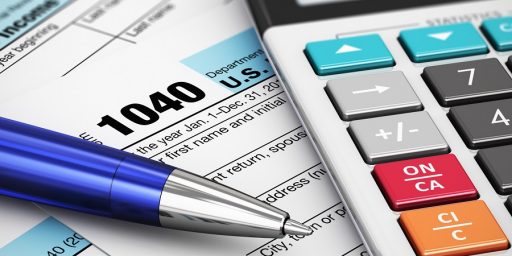The Stealth Tax
Business Week has an interesting piece on the Alternative Minimum Tax, of which I’d heard but had no real understanding.
First enacted in 1969 to rope in 155 fat cats who had escaped paying taxes altogether, the AMT today reaches far beyond the superwealthy dodgers it was supposed to target. This year, more than 3 million taxpayers — most of them middle-class and upper-middle-class couples with kids — are going to get clobbered by the tax. True, these taxpayers have benefited greatly from lower tax rates on income, capital gains, and dividends. But many of these advantages are being eroded by a tax that’s largely hidden, difficult to plan for, and perverse in its consequences.
And odds are, you could be a victim. Those W-2 wage reports and Form 1099 brokerage statements you just received could contain one of the land mines — high state and local taxes, hefty job-related expenses, incentive stock options, or certain kinds of municipal-bond interest — that blow unwitting victims into the AMT swamp. And if you get caught, odds are the price tag will be steep. If you are making between $100,000 and $200,000, figure on paying nearly $3,000 in extra tax.
Just how does the AMT work? Think of it as a parallel universe where you must calculate your taxes twice. First, you fill out your 1040 the regular way — adding up total income, subtracting deductions and personal exemptions to determine taxable income, and then figuring your tax. Under the AMT, you must do the whole thing again. But this time, you are not allowed to use many valuable deductions to reduce your taxable income. You figure what’s owed under the AMT, compare it to your regular tax bill, and pay the higher amount. The excess over the regular bill is, in essence, your AMT.
Interesting. I compute my taxes using software and, sadly, make sufficiently less than $100,000 a year as not to worry about this trap. But, as with any tax based on a fixed dollar amount, inflation and geography can create unintended consequences. A $100,000 a much less now than it was twenty years ago and is much less in Manhattan than in Birmingham.
The AMT went haywire because it does not take inflation into account. The regular tax adjusts brackets and personal exemptions for higher prices and income, but the AMT does not. So as incomes rise, more and more people are caught. And Bush’s recent tax cuts just make matters worse. Since you must pay the higher of the two taxes, the recent changes that lower your regular tax just make it more likely you’ll be paying the AMT.
If you’ve managed to escape the tax so far, your reprieve is almost certainly temporary. The levy is growing like the monster from the tax lagoon. By the end of this decade, barring reform, this stealth tax will strike 33 million annually — or one-third of all taxpayers — according to estimates by the Urban-Brookings Tax Policy Center. It will hit 9 out of 10 making between $100,000 to $500,000 in today’s dollars, and more than 70% of those making $75,000 to $100,000. And it is turning the concept of a progressive tax code on its head: The very wealthy often pay a smaller share of their income in AMT taxes than the upper middle class.
Even for many middle-class families, the AMT and its devilishly complicated Form 6251 will be the tax code — not the regular income tax on Form 1040. “The cop and the nurse with two kids are going to get nailed,” says Brookings Institution tax economist William G. Gale.
***
Washington’s dirty secret is that the minimum tax has become a money machine. Over the next decade, it would cost the feds nearly $1 trillion in foregone revenues to repeal the tax. And even the simplest fix — annual inflation adjustments — would sport a $480 billion price tag, according to the nonpartisan Congressional Budget Office. As more people feel the AMT’s pinch, Washington is likely to respond only with temporary patchwork fixes, as President Bush proposed in his Feb. 2 budget.
***
As it takes over the tax code, the AMT will effectively repeal much of the Bush tax cuts: By 2010, the AMT will swallow one-third of the value of the 2001 and 2003 rate reductions. Taxpayers with incomes of $100,000 to $500,000 will lose two-thirds of their tax cut. And that debate over whether to make President Bush’s rate cuts permanent? It won’t matter to many taxpayers for whom the only rates that will count are the 26% and 28% of the AMT.
For hundreds of thousands of upper-middle-class families, the AMT is already eroding last year’s reductions in capital-gains and dividend taxes. And even as politicians vie to ease taxes on families, the AMT actually imposes a penalty on those who marry. Today, a husband and wife earning $100,000 each, with four kids, will pay $1,470 more in AMT taxes than if they split up. By 2010, married couples will be 20 times as likely to be zinged by the AMT as singles.
Even if you don’t have to pay the tax, you’ll still have to fill out the mind-numbing, 65-line Form 6251 just to find out. That chore is nearly impossible without the help of either tax software or a professional preparer.
(Hat tip: Dean Esmay)






What the story conveniently leaves out is what the effective tax rate (tax/AGI) is for these people so affected and if that is significantly more then people who are not affected pay. Until we know that this story is kind of useless in making a determination about policy. The three thousand in extra taxes they talk about (or about 1.5% of the income group they are describing) seems like a lot but what if that 3 grand is the lion’s share of what they are paying in income tax? In other words without knowing their effective AGI we can’t really make a very good determination on if the ATM is an undue burden or simply a counter to the fact there are more tax shelters at that level.
The complexity of the tax code is relevant but that, ironically, is due to the mind numbing number of deductions, allowances and credits and has nothing to do with marginal rates. To say that the ATM is the cause of the complexity is kind of silly. Hell I say let forget all itemized deductions and reduce marginal rates 5% across the board. But that proposal would not see the light of day in congress.
The AMT is at 28%. This puts it right in the middle of the 28% bracket for Single filers (like Me). So, if I made a little more, I would pay the same RATE, but lose deductions. Cap Gains are Dividends are normally 15%, but you get nailed on the AMT.
Ah I Pretty sure Capital gains never figures into the ATM. But you fail to answer the question, what is the Effective tax rate, the marginal rate is meaningless for the most part.
This is not the only hidden tax. There is an additional tax for Parents who fall into this category.
For example, last year, instead of the $1000.00 per child tax credit, I only received $483.33 per child because I made too much money. Also, my childcare expenses were only allowed a tax credit at 20% of actual expenses, not the higher amount.
The net result is last year I paid an additional $2,510.00 in taxes that would have been a full tax credit for someone making less money. For me, that was an additional 2% tax without even taking into consideration the AMT, which fortunately, I don’t yet “qualify” for.
And Bush has not put in a fix for the AMT into his buget proposals. If it is not fixed and AMT continues, Bush will oversee a transfer of taxation from the very wealth to the upper middle class and and through the cutting of services an increase in taxes per services rendered for all middle and lower income Americans.
Re: not so poor Scott Harris- there are also many benefits that come along with the phase-out of certian tax credits. As income goes up, deductions from home loan interest reduces tax owed by greater amounts. As income goes up, tax-deferred savings accounts become more valuable. As income goes up, tax deductions for state tax reduce taxes by greater amounts per dollar paid in state tax. Other benefits to wealth: sales of homes with capital gains of less than $250,000 are tax free, inheritance of property allows gains from the sale of that property to be from the time of the death rather than when the property was purchased. Their are many parts of the tax code that let income come in with little or no taxation, often they do not apply to lower income persons.
—